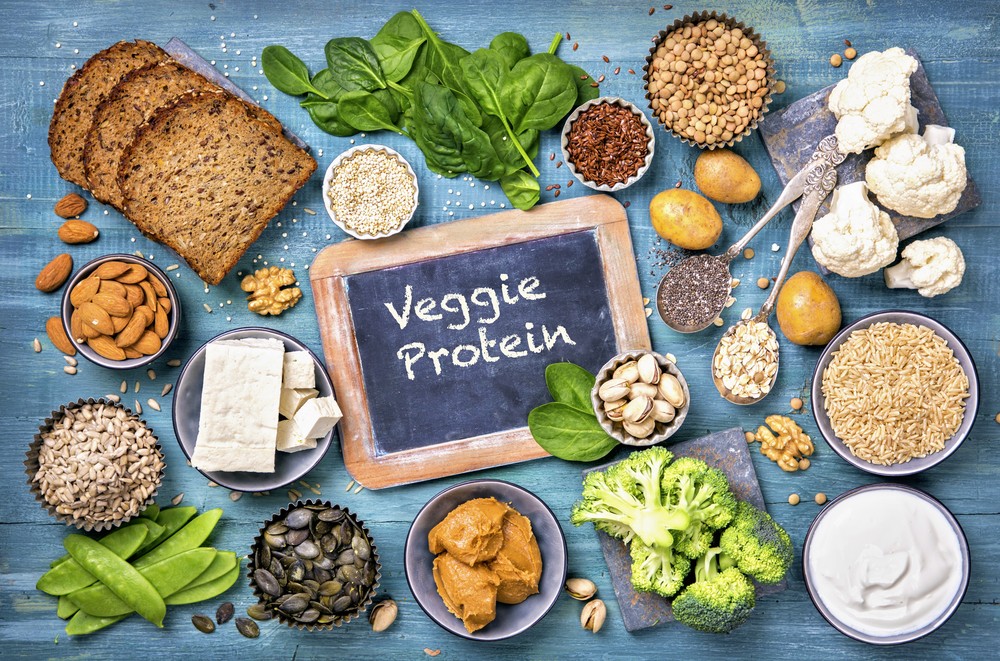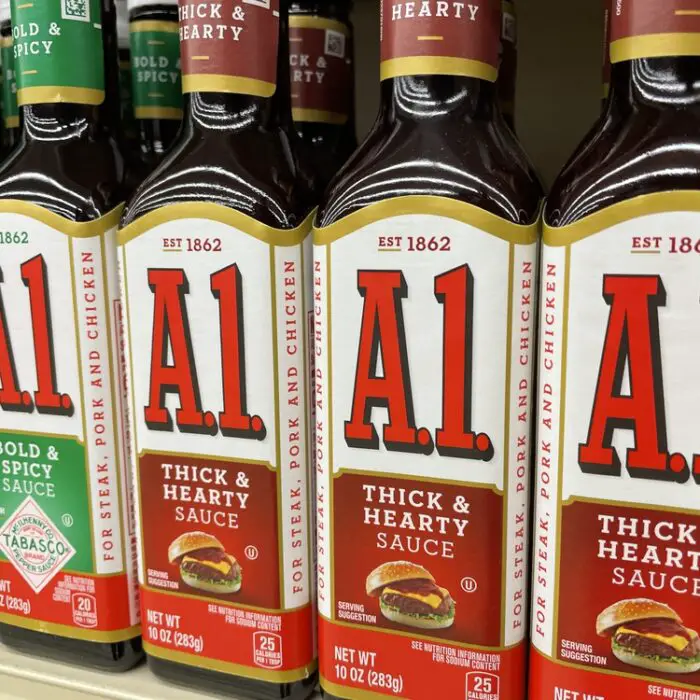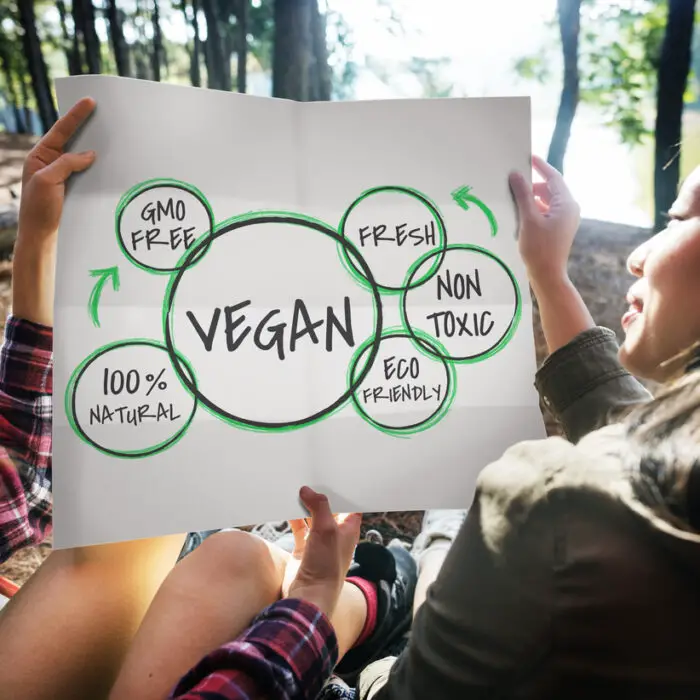Incorporating high-protein vegan meals into your diet can be a strategic move towards weight loss. Many might assume that a vegan diet limits protein sources, but plant-based foods can actually pack a powerful protein punch. Through mindful selection and preparation, you can create satisfying dishes that support your weight loss goals and fuel your body with essential nutrients.
Weight management on a vegan diet hinges on the balance of protein, carbs, and fats. High-protein meals can help by keeping you fuller for more periods, controlling your appetite, and maintaining muscle mass while you shed pounds. By choosing a variety of protein-rich legumes, grains, nuts, and seeds, you can enjoy a diet that’s as nutritious as diverse.
Key Takeaways
- Vegan high-protein meals can be an effective part of a weight loss plan.
- Satiety and muscle mass maintenance from protein-rich foods can aid in managing weight.
- Diverse plant-based proteins ensure a nutritious and varied vegan diet.
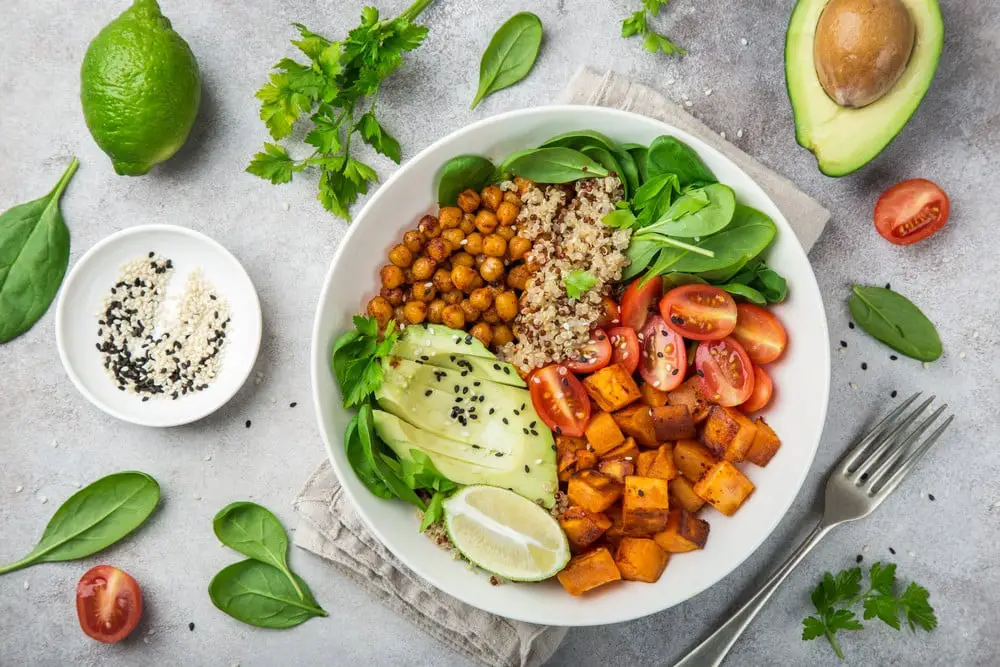
Understanding High-Protein Vegan Foods
Transitioning to a high-protein vegan diet can be a healthful choice. Knowing your key ingredients and their benefits can lead you to effective weight loss and better nutrition.
Protein-Rich Vegan Ingredients
Your journey to a high-protein, plant-based diet starts with identifying ingredients. Here’s a list of staples you’ll want to keep on hand:
- Legumes: Beans, lentils, and chickpeas are versatile and packed with protein.
- Soy Products: Tofu, tempeh, and edamame offer substantial protein. You can use tofu in various dishes, from stir-fries to smoothies.
- Grains: Quinoa is a complete protein source and is easy to incorporate into meals.
- Nuts and Seeds: Almonds, peanuts, chia seeds, and hemp seeds are not only protein-rich but also provide healthy fats.
- Additional Sources: Nutritional yeast and seitan are popular for their savory flavor and high protein content.
Mix and match these ingredients to keep your meals exciting and nutritious.
Benefits of a High-Protein Vegan Diet
Embracing a high-protein vegan diet comes with numerous benefits:
- Weight Management: Protein helps keep you feeling full, which can lead to reduced calorie intake and weight loss.
- Muscle Health: Adequate protein supports muscle repair and growth, especially when exercising regularly.
- Nutritional Boost: Plant proteins come with additional nutrients such as fiber, vitamins, and minerals.
By choosing a variety of protein-rich vegan foods, you’re likely to reap these benefits. Ensure that you incorporate these ingredients regularly for a well-rounded diet.
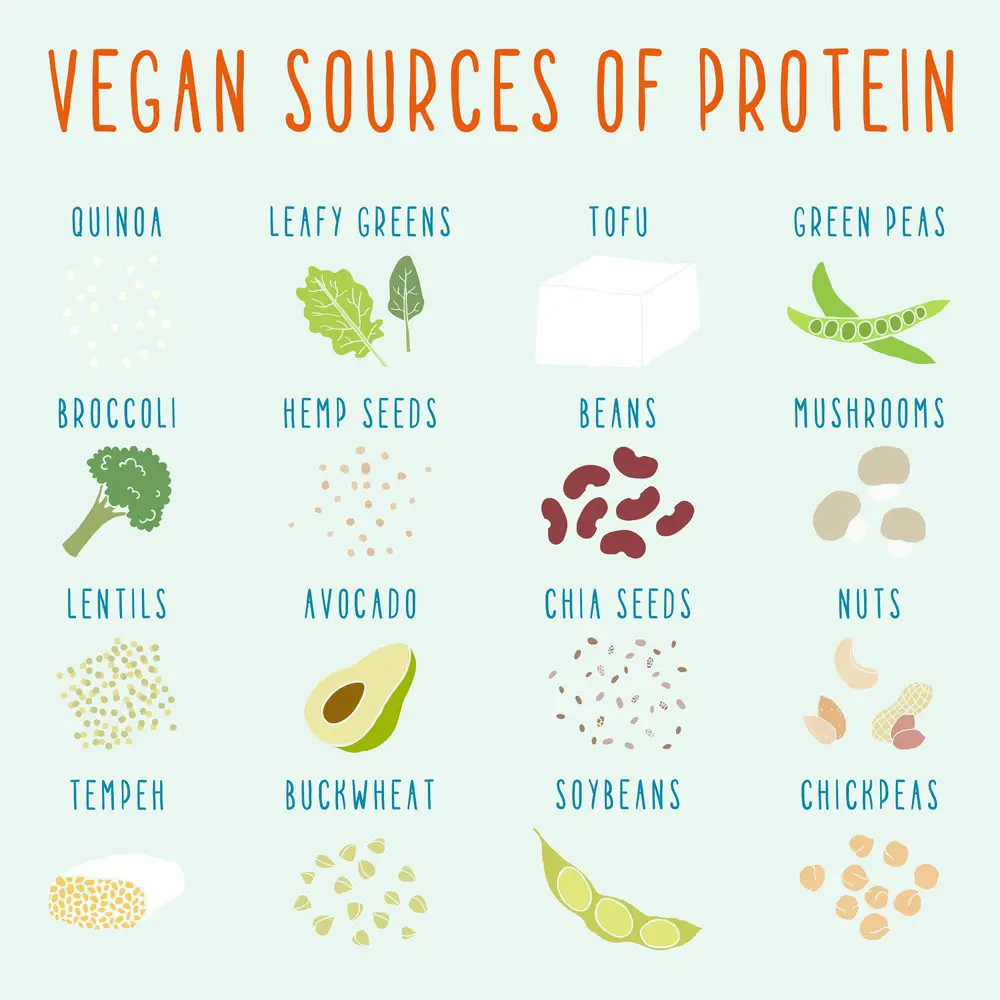 Creating a Balanced Vegan Meal Plan
Creating a Balanced Vegan Meal Plan
Creating a well-rounded meal plan is crucial when embarking on a high-protein, vegan weight loss journey. It helps maintain your protein intake and ensures you’re getting a diversity of nutrients.
Macronutrient Considerations
You aim to hit the sweet spot with your macronutrients: proteins, carbohydrates, and fats. For protein, focus on legumes, tofu, and seitan. Pair these proteins with whole grains for energy, and don’t forget the healthy fats from sources like avocados and nuts. Here’s a quick reference:
- Proteins: lentils, chickpeas, quinoa, tempeh
- Carbohydrates: brown rice, oats, sweet potatoes
- Fats: chia seeds, almonds, olive oil
Remember, fiber is a critical player in satiety, so bulk up on vegetables and fruits.
Key Takeaway: Aim for a balance in your macronutrients, emphasizing protein-rich foods to support weight loss.
Incorporating Variety
Variety isn’t just the spice of life; it’s the cornerstone of nutrition. Rotate your sources of protein to cover all essential amino acids. Experiment with different vegetables and fruits to avoid boredom and ensure you get a spectrum of vitamins and minerals. Your meal plan might include:
- Grains on Mondays and Thursdays
- Legumes on Tuesdays and Fridays
- Different vegetables each day for a rainbow of nutrients
- Fruits as snacks and dessert options
Key Takeaway: Diversifying your meal components helps cover all nutritional bases and keeps meals exciting.
Meal Planning Strategies
A well-thought-out weekly meal plan is your roadmap to success. Start by structuring a 7-day vegan meal plan around your routine, and prepare in advance. Here’s a simplified strategy to get you started:
- Designate a day for meal prep to save time during the week.
- Have a go-to list of recipes for breakfast, lunch, and dinner.
- Ensure each meal contains a protein source to meet your daily protein requirements.
- Plan for snacks high in protein and fiber to keep you full.
Key Takeaway: Pre-planning your meals ensures consistency in your diet and helps you stick to your weight loss goals.
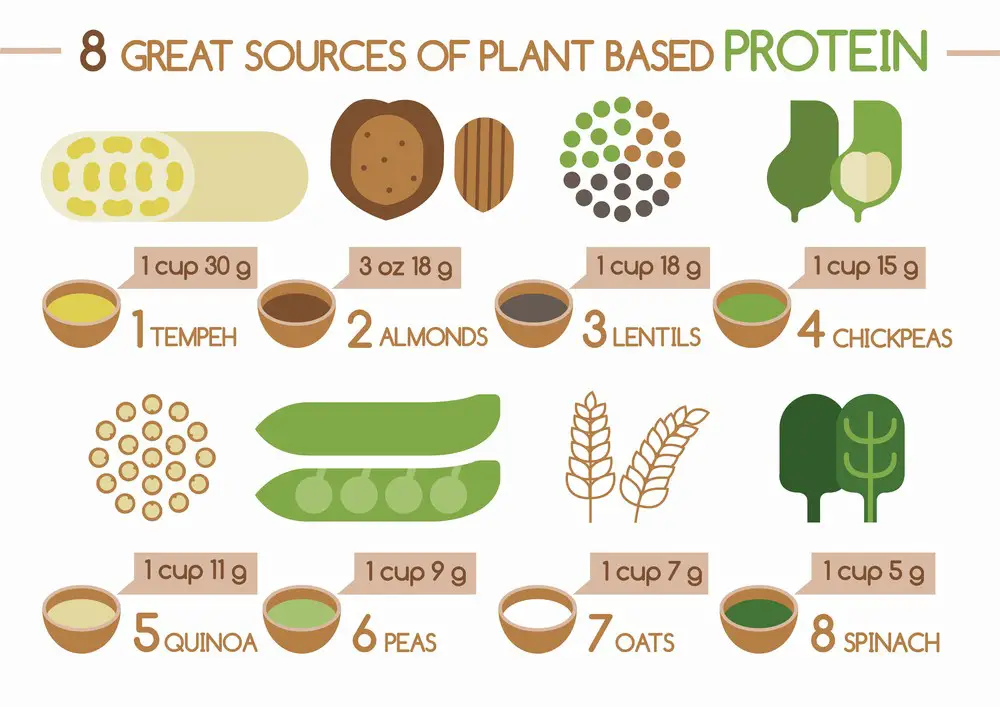 High-Protein Vegan Breakfast Ideas
High-Protein Vegan Breakfast Ideas
Starting your day with a high-protein breakfast can give you the energy to tackle your activities. When it comes to vegan options, plenty of delicious and nutritious choices can help you feel full and support your weight loss goals.
Smoothie Bowls
Your breakfast smoothie bowl can pack a protein punch with the right ingredients. Combine plant-based milk, like almond milk, with a scoop of vegan protein powder, chia seeds, and a mix of your favorite frozen fruits to create a refreshing meal. Here’s a quick guide:
- Base: 1 cup unsweetened almond milk + 1 scoop vegan protein powder
- Thickener: 1/2 frozen banana or 1/2 avocado
- Protein boost: 2 tablespoons chia seeds
- Toppings: Sliced almonds, a sprinkle of oats, seeds
Blend until smooth, pour into a bowl, and add your toppings for a satisfyingly crunchy texture.
Key takeaway: A smoothie bowl is a quick and customizable option packed with proteins and numerous nutrients.
Tofu Scramble
Whip up a savory tofu scramble using firm tofu as your central protein source. Add turmeric for color and nutritional yeast to mimic the flavors you love in traditional scrambled eggs for a cheesy taste. Serve it with a side of whole-grain toast for added fiber. Ingredients you’ll need:
- Main: 1 block firm tofu, crumbled
- Flavor enhancers: Turmeric, nutritional yeast, onion powder, salt, pepper
- Veggies: Spinach, tomatoes, bell peppers, diced
Sauté your veggies, stir in the tofu and seasonings, and cook until hot and flavorful.
Key takeaway: Tofu scramble is a versatile dish with a wide variety of vegetables for extra nutrition.
Vegan Oatmeal Options
Oatmeal is a nutritious breakfast that is naturally high in protein, especially when you add protein-rich toppings. You can try combining ingredients such as almonds and seeds to add texture or add a dollop of almond butter for a creamy taste. Here’s an easy recipe to get you started:
- Oats: 1/2 cup rolled oats, cooked in water or almond milk
- Protein boost: 2 tablespoons pumpkin seeds or hemp seeds
- Flavor: Cinnamon, vanilla extract
- Sweetness: Fresh fruit, a touch of maple syrup
Enjoy a warm, comforting bowl that keeps you full and energized until your next meal.
Key takeaway: Oatmeal is a fantastic canvas for numerous high-protein toppings, allowing for variety in your breakfast routine.
Lunch Recipes for Protein-Packed Afternoons
For a midday meal that aids in weight loss and muscle maintenance, incorporating protein-rich ingredients is key. Vegan sources such as beans, quinoa, and hummus provide sustained energy and essential nutrients to support your busy afternoons.
Bean Salads
Start your lunch with a refreshing bean salad. Beans are a staple in vegan nutrition, offering ample protein and fiber.
- Chickpea Salad: Toss chickpeas with diced tomatoes, cucumber, red onion, and a lemon-tahini dressing for a zesty bite.
- Black Bean Fiesta: Combine black beans with corn, bell peppers, and avocado, dressed in a lime-cilantro vinaigrette.
Key takeaway: Bean salads are a quick, flavorful way to load up on protein and fiber.
Hummus Wraps
Hummus wraps are a versatile and portable option for a satisfying lunch.
- Classic Hummus and Veggie Wrap: Spread hummus on a whole-grain tortilla add strips of cucumber, carrot, and spinach leaves. Roll it up for a crunchy and creamy lunch.
- Mediterranean Wrap: Layer hummus, diced tomatoes, olives, red onion, and shredded lettuce. Drizzle with a bit of olive oil for a touch of richness.
Key takeaway: Hummus wraps balance protein, healthy fats, and veggies.
Quinoa-Based Dishes
Quinoa, a complete protein, makes a hearty base for any lunch dish.
- Quinoa & Bean Chili: Simmer quinoa, black beans, diced tomatoes, and spices for a hearty vegan chili that’s filling and warming.
- Tofu Quinoa Bowl: Pair cooked quinoa with sautéed tofu, steamed broccoli, and a soy-sesame dressing for a nutrient-dense bowl.
Key takeaway: Quinoa-based lunches deliver a complete protein punch that fuels the rest of your day.
Satisfying High-Protein Vegan Dinners
Incorporating high-protein ingredients like tempeh, legumes, and innovative vegan meat alternatives can transform your vegan dinners into a fulfilling weight-loss journey. Let’s dive into some satisfying and protein-rich meal ideas.
Stir-Fries with Tempeh
- Ingredients: Tempeh, assorted vegetables (broccoli, bell peppers, snow peas), low-sodium soy sauce, garlic, ginger.
- Protein Punch: A 3.5-ounce serving of tempeh packs about 19 grams of protein.
- Method: Cube tempeh and sauté with a colorful mix of vegetables. Add your sauce made from garlic, ginger, and soy sauce for an Asian twist.
- Tip: Marinate tempeh in teriyaki sauce beforehand for an extra flavor kick.
Key Takeaway: Tempeh’s versatility and high protein content make it a stir-fry superstar, perfect for a filling dinner.
Hearty Legume Stews
- Base Ingredients: Lentils or beans, diced tomatoes, vegetable broth, onions, carrots, celery.
- Protein Content: One cup of cooked lentils has about 18 grams of protein, while beans offer around 15 grams per cup.
- Method: Simmer all ingredients until the legumes are tender and the flavors meld. Season to taste.
- Variety: Switch up the legumes—try chickpeas, black beans, or a mix for different textures and flavors.
Key Takeaway: Legume stews are rich in protein and fiber, which helps keep you satisfied longer.
Vegan Meat Alternatives
- Main Dishes: Vegan meatloaf with lentils and chickpeas, baked tofu with a crispy crust, teriyaki tofu skewers.
- Protein Stats: Vegan meatloaf can have 15-20 grams of protein per slice, while tofu can offer 10 grams per 3.5-ounce serving.
- Tofu Prep: Press your tofu to remove excess water for an irresistible edge, then marinate before baking or grilling.
- Creative Sides: Pair these mains with quinoa or cauliflower rice for an extra protein boost.
Key Takeaway: Clever use of vegan meat alternatives adds a enjoyable twist to the dinner plate and increases the protein.
Healthy Vegan Snacks for Energy and Nutrition
When aiming for weight loss, choosing snacks high in protein and nutrients is essential. These vegan options maintain energy levels and support nutrition without adding excess calories.
Nut and Seed Mixes
Ingredients:
- Almonds
- Pistachios
- Chia seeds
- Hemp seeds
Preparation:
- Combine a handful of almonds and pistachios in a bowl.
- Sprinkle a tablespoon of chia and hemp seeds for added protein and Omega-3s.
Key Takeaway: Nut and seed mixes balance healthy fats, protein, and fiber, which can help keep you full between meals.
Protein Bars and Shakes
Protein Bar Ingredients:
- Nuts
- Nut butter
- Chia seeds
Preparation:
- Look for bars with a base of nuts and seeds.
- Ensure they are low in added sugars and high in protein (at least 10g per bar).
Protein Shake Ingredients:
- Plant-based protein powder (pea, hemp, or rice)
- Almond milk
- Chia seeds
Preparation:
- Blend the protein powder with almond milk.
- Add a tablespoon of chia seeds for texture and added nutrients.
Key Takeaway: Protein bars and shakes are handy for on-the-go energy and can aid in muscle recovery if consumed post-exercise.
Crunchy Legume Snacks
Legume Options:
- Roasted chickpeas
- Lentil crisps
- Edamame
Preparation:
- Opt for air-fried or baked versions to avoid extra oils.
- Season with your choice of spices for flavor.
Key Takeaway: Legume-based snacks are low in fat, high in protein, and rich in fiber, supporting sustained energy and promoting fullness.
Weight Loss Tips for Vegan Dieters
Maintaining a balanced vegan diet and monitoring your intake can significantly contribute to weight loss. With the right approach, you can ensure you’re getting enough protein and nutrients without consuming excess calories.
Portion Control
Managing portion sizes is key to weight loss, even with high-protein vegan meals. Here’s how you can stay on track:
- Use Smaller Plates: A simple way to control portions is by serving your meals on smaller plates, which can trick your mind into feeling satisfied with less food.
- Read Food Labels: Pay attention to serving sizes on packaged foods to avoid overeating.
- Listen to Your Body: Eat slowly and mindfully, stopping when you’re full rather than when your plate is empty.
Key Takeaway: Always be aware of the amount you eat. Overeating healthy foods can still lead to weight gain.
Whole Foods Emphasis
Focusing on whole foods can boost your nutrient intake and support weight loss. Here are strategies to enhance your vegan diet:
- Prioritize High-Protein Vegetables: Incorporate veggies like broccoli, spinach, and Brussels sprouts, which are rich in both protein and fiber.
- Choose Plant-Based Proteins: Items like lentils, chickpeas, and quinoa are not only high in protein but also low in calories, which assists in weight management.
- Avoid Processed Foods: Even vegan foods can be heavily processed and high in calories. Stick to whole, unprocessed foods whenever possible.
Key Takeaway: By choosing whole and high-protein foods, you’ll nourish your body with the nutrients it needs for weight loss success.
High-Protein Food Preparation Techniques
Preparing high-protein vegan meals is about choosing the right ingredients and mastering a few cooking methods. Let’s walk through some key techniques that will help you pack a protein punch into your vegan dishes.
Cooking Legumes
Legumes are a protein powerhouse, and cooking them just right can make all the difference. Here’s how to do it:
- Rinse thoroughly: Always start by rinsing your beans and lentils to remove any dirt or impurities.
- Soaking: Soak them overnight to shorten cooking time and improve digestibility.
- Cooking: Simmer legumes until tender. This can take anywhere from 15 minutes for lentils to a couple of hours for chickpeas.
Key Takeaway: Soaking legumes reduces cooking time and ensures you get a tender, more digestible meal.
Baking Tofu
To get that perfect crispy baked tofu, follow these steps:
- Pressing: Wrap your tofu in a clean towel and set a heavy object on top for about 30 minutes to press out excess water.
- Seasoning: Cut tofu into cubes or slices and marinate with your favorite herbs and spices to infuse flavor.
- Baking: Arrange tofu on a lined baking sheet and bake at 400°F (200°C) until crispy, turning halfway through.
Key Takeaway: Pressing tofu is crucial for achieving a crispy texture when baking.
Creating Seitan and Tempeh Dishes
Seitan and tempeh are fantastic sources of vegan protein. Here’s how to prepare them:
- Seitan: Knead vital wheat gluten with spices and liquids to form a dough. Simmer in broth to cook.
- Tempeh: Marinate sliced tempeh in soy sauce, garlic, and other flavors before cooking.
- Versatility: Both can be pan-fried, grilled, or even shredded to resemble the texture of meat in various recipes.
Key Takeaway: Marinating tempeh before cooking unlocks deep flavors, while proper simmering turns seitan into a delightful meat substitute.
Supplementing Your Vegan Diet with Protein
Protein is a cornerstone nutrient for weight loss and muscle maintenance. As you embrace a vegan lifestyle, finding quality protein sources that align with your dietary preferences becomes crucial.
Protein Powders
Protein powders are a convenient addition to your vegan diet. Here’s a handful of plant-based options:
- Pea Protein: Rich in essential amino acids, it’s a great option to support your daily protein needs.
- Hemp Protein: Not only does it offer protein, but it also provides omega-3 fatty acids and fiber.
- Brown Rice Protein: A good alternative for soy or pea allergies.
Key Takeaway: Mixing these powders in smoothies, oats, or baking recipes can boost your protein intake effortlessly.
Supplement Timing and Dosage
Understanding when and how much protein to take can optimize your diet:
- Morning: Kickstart your metabolism with a protein smoothie.
- Post-Workout: A scoop of protein within 30 minutes can aid in recovery.
- Before Bed: A small protein-rich snack can prevent muscle breakdown overnight.
Dosage Strategy:
- Read Labels: Aim for supplements with minimal additives.
- Calculate Need: General guidance suggests daily 0.8g of protein per kilogram of body weight (read to the end for more specifics).
- Adjust Accordingly: Your activity level and goals might require higher intake.
Key Takeaway: Timely protein supplementation can efficiently support your weight loss and muscle repair.
Navigating Social Situations and Dining Out
When embracing a high-protein vegan diet, social gatherings and restaurant dining need not be a challenge; with the right approach, you can enjoy these occasions while staying true to your nutritional goals.
Vegan-Friendly Restaurants
Finding the right spot:
- Look for restaurants with clear vegan options on the menu.
- International cuisines like Indian, Thai, and Middle Eastern often have inherently vegan dishes rich in protein.
- Use apps or websites dedicated to finding vegan dining options.
Key Takeaway: Research is your friend when locating vegan-friendly restaurants that cater to your protein needs.
Food Communication Tips
Expressing your dietary needs:
- Be clear and polite about your dietary restrictions when ordering.
- Spotlight on Protein: Ask about plant-based protein sources like lentils, chickpeas, tofu, and quinoa.
Meal planning:
- Review the menu online before visiting to plan your meal.
- Consider calling ahead to discuss vegan meal options, ensuring your high-protein needs are met.
Key Takeaway: Effective communication with restaurant staff leads to a seamless dining experience, ensuring your plant-based diet is accommodated.
The Science and Research Behind Vegan Diets
Vegan diets are supported by a growing body of scientific research indicating potential health benefits and nutritional adequacy when well-planned and balanced.
Nutritional Studies
Research consistently points to plant-based diets, including veganism, as rich sources of essential nutrients when proper attention is given to meal composition. A focus on plant-based proteins—such as lentils, chickpeas, quinoa, and nuts—can meet and exceed the recommended dietary allowance (RDA) for protein set by the USDA. For instance, a cup of cooked lentils provides about 18 grams of protein, rendering it a powerhouse for those on a vegan diet. Key findings include:
- Adequate Protein: You can achieve the necessary protein intake solely from plants. Consuming various plant-based protein sources throughout the day can help ensure a balance of essential amino acids.
- Vitamins and Minerals: Certain nutrients, like B12, may need supplementation or a conscientious dietary source, such as fortified foods, to meet required levels without animal products.
Key Takeaway: You can obtain all nutrients required for good health on a vegan diet with careful meal planning and an understanding of plant-based protein sources.
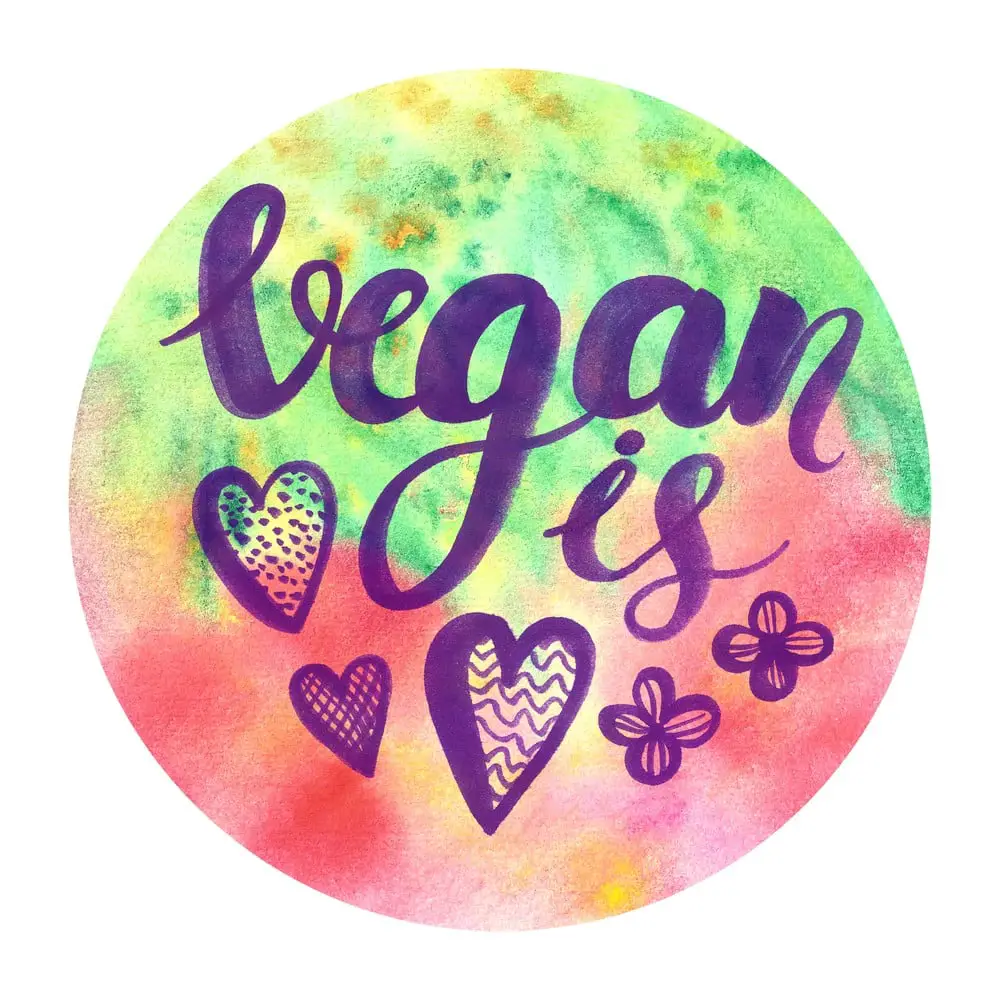 Environmental and Ethical Considerations
Environmental and Ethical Considerations
The shift toward vegan diets also reflects an awareness of environmental and ethical issues associated with animal agriculture. Studies suggest that plant-based diets are more sustainable and have a lower ecological footprint, reducing greenhouse gas emissions and land use. Ethical motivations often intertwine with health considerations, advocating for the welfare of animals and a reduction in exploitation. To illustrate:
- Resource Allocation: Agriculture geared towards feeding livestock consumes more water and land than crops grown directly for human consumption.
- Climate Impact: The production of animal-based foods typically emits more greenhouse gases compared to plant-based foods, leading to a heavier environmental toll.
Key Takeaway: By choosing a vegan diet, you’re potentially contributing to environmental preservation and supporting the ethical treatment of animals, aligning with a compassionate lifestyle choice.
Harnessing the Power of Protein for Effective Weight Loss
Protein is not just a vital component of a healthy diet; it’s a powerhouse when it comes to weight loss. Understanding its role and how to effectively incorporate it into your vegan diet can make your weight loss journey both enjoyable and successful. Here’s why protein deserves a starring role in your weight-loss plan:
- Satiety and Fullness: Protein is more filling than carbohydrates or fats. This means that high-protein meals can help you feel fuller for longer, reducing the temptation to snack on less healthy options.
- Boosts Metabolism: Your body uses more energy to digest protein compared to other nutrients, a phenomenon known as the thermic effect of food. Incorporating protein into your meals can slightly boost the number of calories you burn, aiding in weight loss.
- Preserves Muscle Mass: When losing weight, it’s important to lose fat, not muscle. Protein helps preserve lean muscle mass, ensuring that most of the weight you lose is fat.
- Versatile and Delicious: From savory tofu scrambles to creamy lentil soups, protein-rich vegan foods are diverse and delicious. They allow for creative cooking, ensuring your diet remains exciting and varied.
Tips for Incorporating Protein into Your Vegan Diet
- Diversify Your Sources: Beans, lentils, tofu, tempeh, and seitan are excellent protein sources. Experiment with different types to find your favorites.
- Snack Smartly: Opt for protein-rich snacks like roasted chickpeas or hummus with veggies.
- Protein-Packed Breakfasts: Start your day with a protein-rich meal like a smoothie with vegan protein powder, chia seeds, and nut butter.
- Balance Your Plate: Ensure each meal has a good balance of protein, healthy fats, and fiber-rich carbohydrates.
- Stay Hydrated: Drinking plenty of water is crucial, especially when increasing protein intake.
Remember, while protein is key, a balanced approach to dieting is essential. Combining a high-protein vegan diet with regular exercise and healthy lifestyle choices will set you on the path to sustainable weight loss.

Finding the Right Balance: How Much Protein Do You Really Need?
Determining the right amount of protein for your body is crucial. While protein is essential for health and weight loss, balance is key. Here’s how to figure out how much protein you need:
- General Guidelines: The Recommended Dietary Allowance (RDA) for protein is 0.8 grams per kilogram of body weight. However, if you’re aiming for weight loss or muscle gain, this number might increase to around 1.2 to 1.7 grams per kilogram.
- Personal Factors: Consider your age, activity level, muscle mass, and overall health. For instance, if you’re very active, you might need more protein than someone who is less active.
- Use Online Calculators: There are many online tools that can help you estimate your protein needs based on your personal details and goals.
Recognizing the Signs of Excess Protein Intake
While protein is important, too much of it can lead to health issues. Here’s what to look out for:
- Digestive Issues: High protein intake, especially without enough fiber, can lead to constipation or other digestive discomforts. This is a particular issue with animal proteins like chicken and meat, vegan proteins like nuts and beans are fiber-rich.
- Dehydration: Protein requires more water to metabolize, so high protein intake without adequate water can lead to dehydration.
- Kidney Strain: In individuals with pre-existing kidney conditions, excessive protein can put additional strain on the kidneys.
- Nutrient Imbalance: Focusing too much on protein can lead to a lack of other essential nutrients found in fruits, vegetables, and whole grains.
- Weight Gain: Protein still contains calories. Consuming too much, especially without exercise, can lead to weight gain.
Tips for Managing Protein Intake
- Track Your Meals: Consider using a food diary app to keep track of your protein intake and ensure it’s within a healthy range.
- Listen to Your Body: Pay attention to how your body reacts to different levels of protein intake.
- Consult a Professional: If in doubt, consult a dietitian or nutritionist who can provide personalized advice based on your specific needs.
Remember, while protein is a key part of a healthy diet, it’s all about balance. Listening to your body and adjusting your intake according to your personal health goals and lifestyle is the best strategy for effective and healthy weight loss.
Frequently Asked Questions
In the search for nourishing vegan meals that pack a protein punch, questions often arise regarding cost, protein content, meal planning, and more. The following FAQ tackles these queries head-on.
What are some budget-friendly vegan meals with high protein content?
You’ll find that lentils, chickpeas, and black beans are wallet-friendly and rich in protein. A simple lentil stew or a chickpea curry can deliver protein without straining your budget. Your key takeaway: plant-based proteins can be both economical and nutritious.
How can I incorporate 30 grams of protein into a single vegan meal?
Combine various sources like tofu, tempeh, and edamame in your meals to hit that protein target. An example might be a stir-fry with tofu paired with a side of quinoa and steamed edamame, adjusting portions to meet your protein needs. Remember, mixing different proteins can make it easier to reach your goal.
What does a high protein vegan meal plan for muscle gain entail?
For muscle gain, focus on meals with hearty protein sources such as seitan, tofu, and diverse legumes. Include a range of veggies for vitamins and minerals. A day might start with a protein smoothie, a quinoa and black bean salad for lunch, and a seitan stir-fry for dinner.
Can you suggest high protein, low carb vegan meal options?
Sure can! Opt for dishes centered around plant proteins like tempeh and tofu. Leafy greens, mushrooms, and seeds add nutrient-rich richness without carbs. A salad with grilled tempeh and avocado or a tofu scramble with spinach are great choices. The takeaway is to favor protein-dense foods and fibrous vegetables.
What are some high protein vegan snacks that are also low in calories?
Roasted chickpeas, edamame, and homemade protein bars can satisfy your hunger without too many calories. A smoothie with pea protein powder can also give you a quick protein boost. These snacks will curb your appetite without the calorie overload.
What are the best high protein vegan meals suitable for freezing?
Chili made from lentils and beans or veggie patties primarily made with chickpeas and oats are ideal for freezing. These meals retain their flavor and nutritional integrity after thawing. Plus, they’re always ready for a quick, protein-rich meal.

